Better than expected data on the economy lifted stocks and punished treasuries. The ISM Manufacturing Index rose to 51.7 in October. Anything above 50 favors economic expansion. In a preview of today's non-farm payroll report, the ADP Employment report showed the biggest increase in private payrolls since January. Should this number hold true, we could see today's employment report beat expectations, which would be positive for stocks and negative for treasuries. The chart below shows the S&P MidCap 400 SPDR (MDY) leading the charge with a surge above consolidation resistance and a wedge breakout. MDY held up the best in early October and started showing relative strength in mid October. This wedge breakout is bullish as long as it holds. A move back below 179 would negate the breakout.
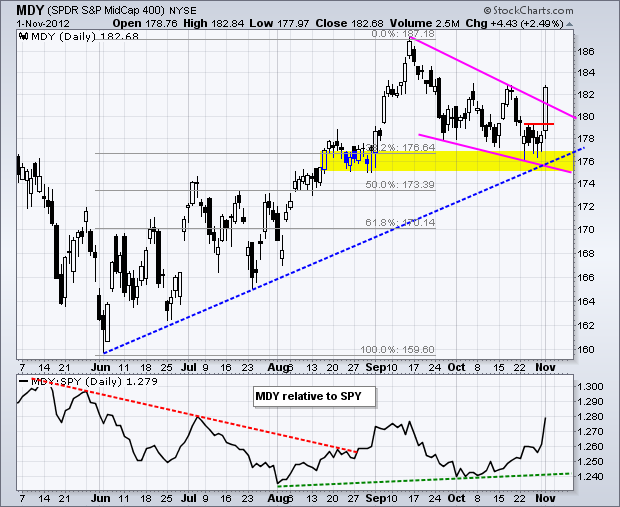


On the 30-minute chart, SPY surged above first resistance and then stalled at key resistance. The ETF formed a tight consolidation after the first hour surge. This looks like a high and tight flag. A break above flag resistance would signal a continuation higher and target a move to the 145 area. The height of the flag (pole) is added to the flag low for a target. Flags are said to fly at half-mast.
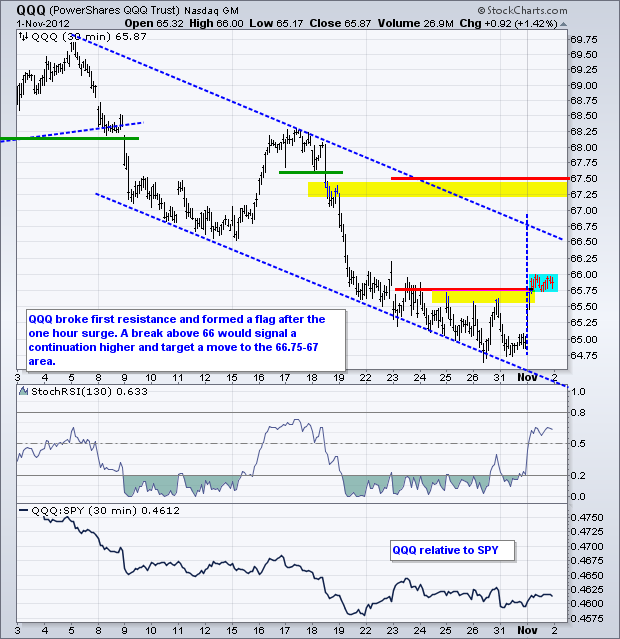
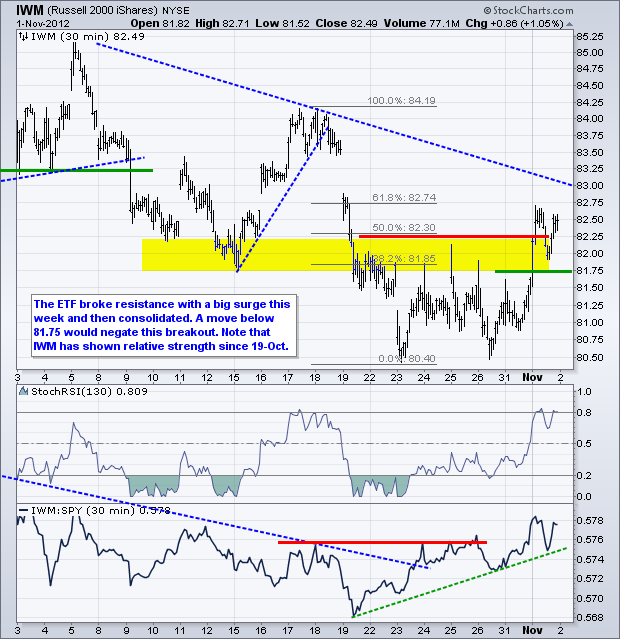
**************************************************************************
The 20+ Year T-Bond ETF (TLT) remains all over the place as the ETF crossed the 122 level at least seven times in the last five weeks. This week's breakout at 122 is bullish, but only as long as it holds. Broken resistance turns first support at 122. A move back below this level would put the bears back in play. Today marks the moment-of-truth with the employment report.
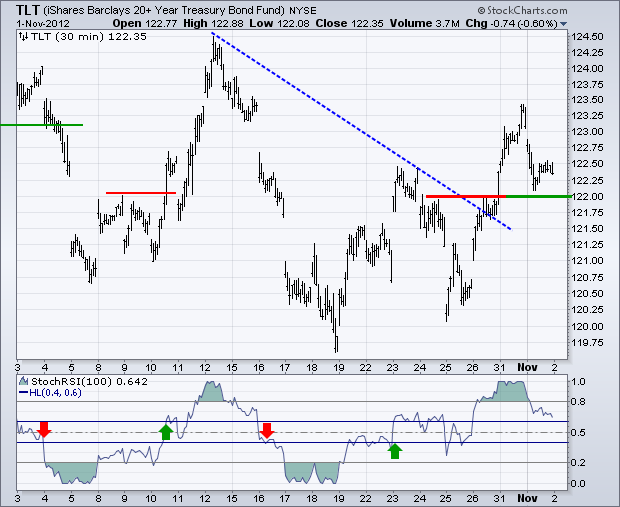
**************************************************************************
No change. The US Dollar Fund (UUP) surged to resistance and then consolidated the last five days. A consolidation after a surge is usually bullish and a breakout would signal a continuation higher. The greenback will also focus on the economic data and the elections. Strong economic numbers would favor the risk-on trade, which would be bearish for the Dollar. Weak economic reports would favor the risk-off trade, which would be bullish for the Dollar.
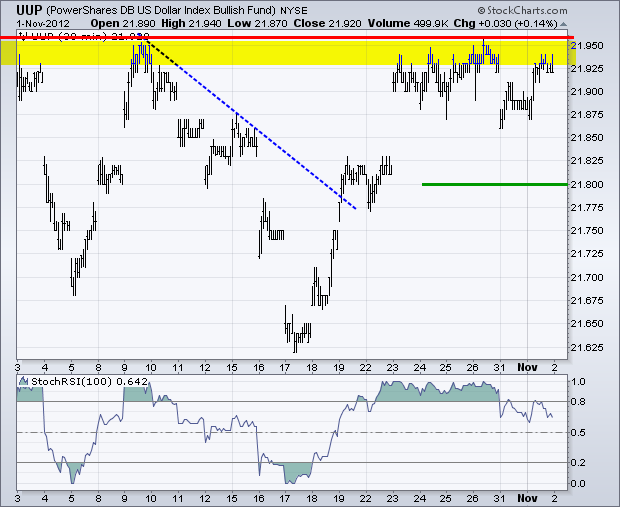
**************************************************************************
No change. The US Oil Fund (USO) broke down in mid September and again in mid October. Even though oil is oversold, buying pressure is nonexistent as it consolidates at low levels. A break below 31.50 would signal a continuation lower. Broken support turns into first resistance in the 33-33.50 area. Key resistance remains just above 34.50.
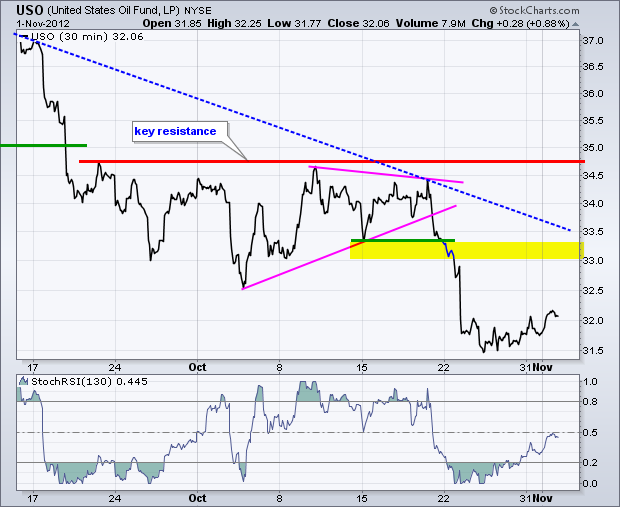
**************************************************************************
No change. The Gold SPDR (GLD) moved higher over the last few days and broke the trend line extending down from early October. I am not quite ready to call this a short-term uptrend just yet though. Broken support turns resistance at 138 and follow through is needed to fully reverse this downtrend. The advance over the last few days formed a rising wedge, which is a bearish consolidation pattern. Follow-through failure and a break below wedge support would signal a continuation lower.
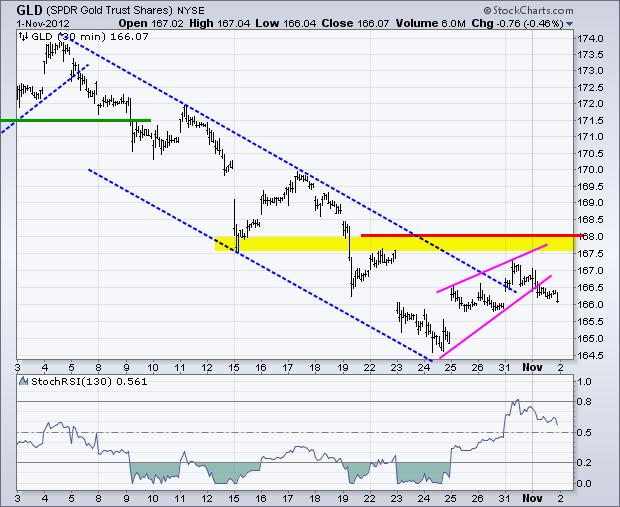
**************************************************************************
Key Reports and Events:
Thu – Nov 01 - 08:15 - ADP Employment Report
Thu - Nov 01 - 07:30 - Challenger Job Report
Thu - Nov 01 - 08:30 - Jobless Claims
Thu - Nov 01 - 10:00 - ISM Manufacturing Index
Thu - Nov 01 - 10:00 - Construction Spending
Thu - Nov 01 - 10:00 – Consumer Confidence
Thu - Nov 01 - 14:00 - Auto/Truck Sales
Fri - Nov 02 - 08:30 - Employment Report
Fri - Nov 02 - 10:00 - Factory Orders
Tue - Nov 06 - 08:00 - Election Day
Charts of Interest: Tuesday and Thursday
This commentary and charts-of-interest are designed to stimulate thinking. This analysis is not a recommendation to buy, sell, hold or sell short any security (stock ETF or otherwise). We all need to think for ourselves when it comes to trading our own accounts. First, it is the only way to really learn. Second, we are the only ones responsible for our decisions. Think of these charts as food for further analysis. Before making a trade, it is important to have a plan. Plan the trade and trade the plan. Among other things, this includes setting a trigger level, a target area and a stop-loss level. It is also important to plan for three possible price movements: advance, decline or sideways. Have a plan for all three scenarios BEFORE making the trade. Consider possible holding times. And finally, look at overall market conditions and sector/industry performance.


**************************************************************************
The 20+ Year T-Bond ETF (TLT) remains all over the place as the ETF crossed the 122 level at least seven times in the last five weeks. This week's breakout at 122 is bullish, but only as long as it holds. Broken resistance turns first support at 122. A move back below this level would put the bears back in play. Today marks the moment-of-truth with the employment report.

**************************************************************************
No change. The US Dollar Fund (UUP) surged to resistance and then consolidated the last five days. A consolidation after a surge is usually bullish and a breakout would signal a continuation higher. The greenback will also focus on the economic data and the elections. Strong economic numbers would favor the risk-on trade, which would be bearish for the Dollar. Weak economic reports would favor the risk-off trade, which would be bullish for the Dollar.

**************************************************************************
No change. The US Oil Fund (USO) broke down in mid September and again in mid October. Even though oil is oversold, buying pressure is nonexistent as it consolidates at low levels. A break below 31.50 would signal a continuation lower. Broken support turns into first resistance in the 33-33.50 area. Key resistance remains just above 34.50.

**************************************************************************
No change. The Gold SPDR (GLD) moved higher over the last few days and broke the trend line extending down from early October. I am not quite ready to call this a short-term uptrend just yet though. Broken support turns resistance at 138 and follow through is needed to fully reverse this downtrend. The advance over the last few days formed a rising wedge, which is a bearish consolidation pattern. Follow-through failure and a break below wedge support would signal a continuation lower.

**************************************************************************
Key Reports and Events:
Thu – Nov 01 - 08:15 - ADP Employment Report
Thu - Nov 01 - 07:30 - Challenger Job Report
Thu - Nov 01 - 08:30 - Jobless Claims
Thu - Nov 01 - 10:00 - ISM Manufacturing Index
Thu - Nov 01 - 10:00 - Construction Spending
Thu - Nov 01 - 10:00 – Consumer Confidence
Thu - Nov 01 - 14:00 - Auto/Truck Sales
Fri - Nov 02 - 08:30 - Employment Report
Fri - Nov 02 - 10:00 - Factory Orders
Tue - Nov 06 - 08:00 - Election Day
Charts of Interest: Tuesday and Thursday
This commentary and charts-of-interest are designed to stimulate thinking. This analysis is not a recommendation to buy, sell, hold or sell short any security (stock ETF or otherwise). We all need to think for ourselves when it comes to trading our own accounts. First, it is the only way to really learn. Second, we are the only ones responsible for our decisions. Think of these charts as food for further analysis. Before making a trade, it is important to have a plan. Plan the trade and trade the plan. Among other things, this includes setting a trigger level, a target area and a stop-loss level. It is also important to plan for three possible price movements: advance, decline or sideways. Have a plan for all three scenarios BEFORE making the trade. Consider possible holding times. And finally, look at overall market conditions and sector/industry performance.

About the author:
Arthur Hill, CMT, is the Chief Technical Strategist at TrendInvestorPro.com. Focusing predominantly on US equities and ETFs, his systematic approach of identifying trend, finding signals within the trend, and setting key price levels has made him an esteemed market technician. Arthur has written articles for numerous financial publications including Barrons and Stocks & Commodities Magazine. In addition to his Chartered Market Technician (CMT) designation, he holds an MBA from the Cass Business School at City University in London.
Learn More